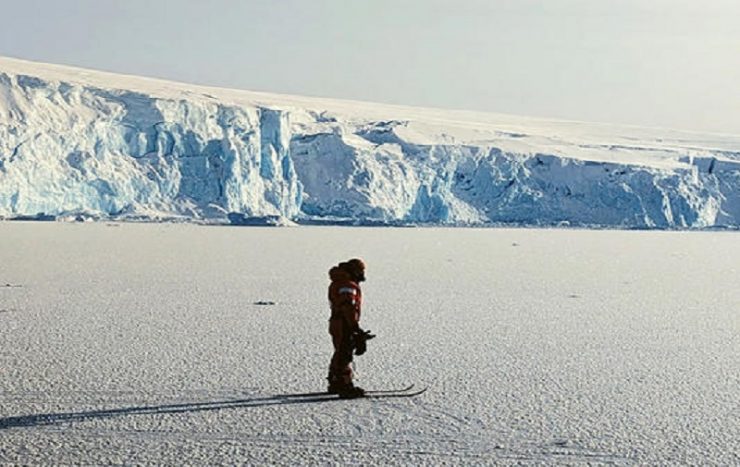THE AMOUNT of ice in the ocean surrounding Antarctica is well below any winter level ever recorded, according to satellite data. This is a worrying new sign for a region that once seemed able to survive global warming.
“This is so far beyond anything we’ve ever observed, it could even be called amazing,” said Walter Meier, who monitors sea ice at the United States’ National Snow and Ice Data Center (NSDC).
Experts warn that an unstable Antarctica could have far-reaching consequences. Antarctica’s vast expanse of ice regulates planet Earth’s temperature, because its white surface reflects the sun’s energy back into the atmosphere while cooling the water below and nearby. Without ice to cool the planet, Antarctica could turn from a refrigerator into Earth’s radiator, experts say.
Floating ice on the surface of the Antarctic Ocean now measures less than 17 million square km, or 1.5 million square km less than the September average, and well below record lows in previous winters. The area of the lost ice is about five times the size of the British Isles.
Dr Meier is not optimistic that sea ice will recover to significant levels. Scientists are still trying to identify all the factors that led to low sea ice this year — but studying trends in Antarctica hasn’t been easy.
In a year when several global ocean heat and temperature records have been broken, some scientists insist that low sea ice levels are a measure of concern.
“We can see for ourselves how vulnerable it is,” said Dr Robbie Mallet, from the University of Manitoba, which is based on the Antarctic peninsula.
In addition to the isolated research conditions, extreme cold and strong winds, thin sea ice this year made the team’s work even more difficult.
“There is a risk of the ice sheet breaking off and being washed out to sea with us on top of it,” Dr Mallet remarked.
Sea ice forms during winter on the Antarctic continent (between March and October), before most of it melts in summer. Sea ice is part of an interconnected system, which also consists of icebergs, land ice, and large ice floes — extensions of land ice that float in the water and jut out from the coast. Sea ice acts as a protective layer for the land-covering ice and prevents sea water from heating up.
Meanwhile Dr Caroline Holmes at the British Antarctic Survey explains that the impact of shrinking sea ice could become apparent as it transitions to summer — when there is the potential for an unstoppable ice melt feedback cycle.
As more sea ice disappears, it increasingly exposes dark areas in the ocean, which absorb sunlight instead of reflecting it; meaning that heat energy is added to the water, which consequently melts more ice. Scientists call this the ice-albedo effect.
That could add more heat to planet Earth, undermining Antarctica’s role as a global temperature regulator.
“Did we wake up this Antarctic giant?” asked Professor Martin Siegert, an expert in glaciology (the science of ice) at the University of Exeter.
He explained that this would be “an absolute disaster for the world. There are signs that what is already happening to the Antarctic ice sheet is within the worst-case scenario range of scientists’ predictions, said Professor Anna Hogg, an Earth expert at the University of Leeds.
Since the 1990s, the loss of land ice from Antarctica has contributed to a sea level rise of 7.2 mm. Even a small rise in sea level can result in very high storm surges that can wipe out communities in coastal areas.
If large amounts of land ice began to melt, the impact would be catastrophic for millions of people around the world. We never thought extreme weather events could occur there. As an independent continent surrounded by water, Antarctica has its own weather and climate system.
By 2016, Antarctic winter sea ice had actually increased in size. But in March 2022 an extreme heatwave hit East Antarctica, pushing temperatures to -10C when they should have been closer to -50C.
“When I started studying Antarctica 30 years ago, we never thought extreme weather events could occur there,” said Professor Siegert.
Sea ice has broken minimum records in summer for three of the last seven years, including February 2023. Some scientists even believe these record low ice levels may indicate that fundamental changes are occurring in Antarctica — shifts in the conditions that have long kept the region isolated.
“Antarctica’s remote location and lack of historical information means much remains unknown. This region is still considered the “Wild West” scientifically,” said Dr Robbie Mallet.
Scientists know how far sea ice spreads, but don’t know, for example, how thick it is. Unraveling that puzzle could radically change climate models for the region.
At the Rothera science base, Dr Mallet uses radar instruments to study sea ice thickness for an international research project called Defiant. He and other scientists are still trying to decipher the causes of the winter ice disappearance.
“It’s possible that it’s a really strange expression of natural variability,” he said, meaning that multiple natural factors could have formed and influenced the region simultaneously.
This year’s record warm oceans are likely one contributing factor, scientists suspect — warm water simply won’t freeze. And there could also be changes in ocean currents and winds that drive temperatures in Antarctica.
The El Nino weather phenomenon, currently underway in the Pacific, could also subtly contribute to sea ice shrinkage, although it is still weak.
Dr Mallet says there is very, very good reason to be concerned. This could potentially be a sign of very worrying changes in the Antarctic climate that have not occurred in the last 40 years. And it’s just showing up now. [antaranews]
















